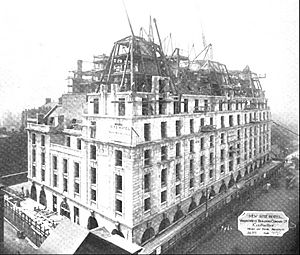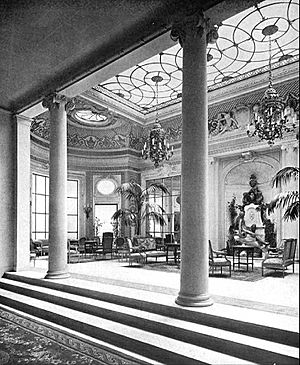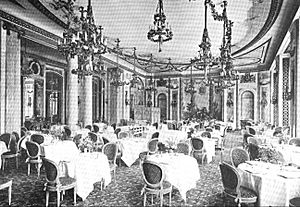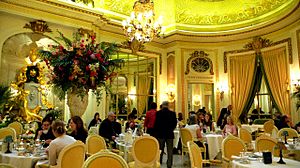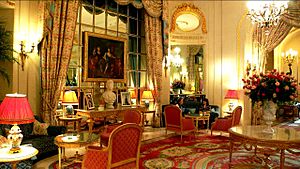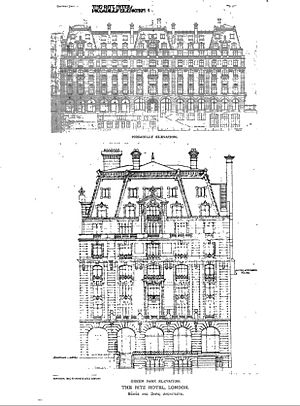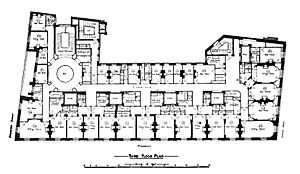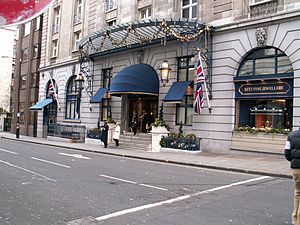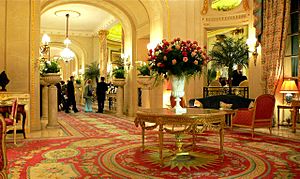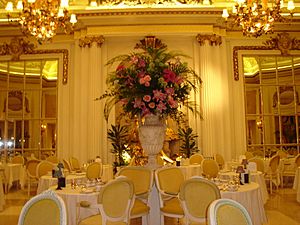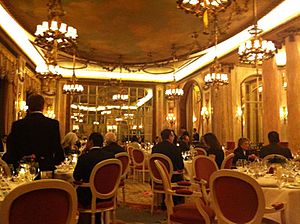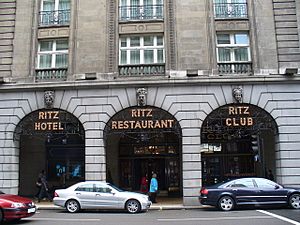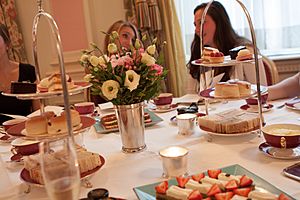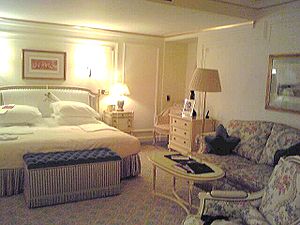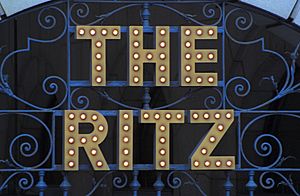The Ritz Hotel, London facts for kids
Quick facts for kids The Ritz London |
|
|---|---|
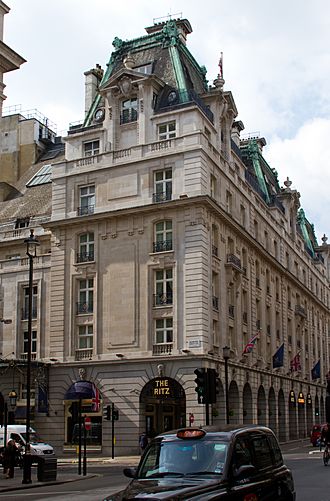 |
|
| General information | |
| Location | 150 Piccadilly, London, United Kingdom |
| Opened | 24 May 1906 |
| Owner | Abdulhadi Mana Al-Hajri |
| Design and construction | |
| Architect | Charles Mewès Arthur Davis |
| Developer | César Ritz |
| Other information | |
| Number of rooms | 111 |
| Number of suites | 23 |
| Number of restaurants | 3 |
The Ritz London is a very famous and luxurious 5-star hotel in Piccadilly, London, England. It is a Grade II listed building, which means it's important and protected. The Ritz is known worldwide for its elegance and high society.
The hotel is part of a group called The Leading Hotels of the World. The word "ritzy" even came from the hotel's name! It means something that is very stylish, fancy, or fashionable.
A Swiss hotel owner named César Ritz opened the hotel in May 1906. This was eight years after he opened the Hôtel Ritz Paris. At first, the hotel was not very busy. But it became popular after World War I. Many famous people like politicians, writers, and actors started to visit. For example, David Lloyd George had secret meetings there during the war.
The Bracewell-Smith family owned the hotel until 1976. Then, The Ellerman Group of Companies bought it in 1995 for £80 million. They spent eight years and £40 million to make it look grand again. In 2002, the Ritz was the first hotel to get a special award called a Royal warrant from the Prince of Wales. This was for its excellent food and event services. In March 2020, a new owner from Qatar bought the hotel.
The outside of the hotel looks like buildings from Paris and America. It doesn't look much like traditional English buildings. The front on Piccadilly is about 231 feet long. The hotel has 111 rooms and 25 suites. You can see large green copper lions on the roof corners. These lions are the hotel's symbol.
The inside of the hotel is designed in the Louis XVI style. This style is seen throughout the hotel. One author, Marcus Binney, said the main rooms on the ground floor are "one of the all-time masterpieces of hotel architecture." He compared it to a royal palace with its grand look and sparkling chandeliers.
The most famous part of the Ritz is the Palm Court. This is where the famous "Tea at the Ritz" is held. It's a beautiful room decorated in a cream color with mirrors and gold frames. The hotel also has six private dining rooms. The Rivoli Bar was designed in 2001 to look like a bar on the Orient Express train.
Contents
Discovering the Ritz London's Past
How the Ritz London Was Built
The Ritz London was opened by Swiss hotelier César Ritz on May 25, 1906. He used to manage the Savoy Hotel. The new hotel was built where an old coaching inn, the Old White Horse Cellar, once stood. People who invested in the Ritz thought they had found one of the best spots in London. They bought the land in 1902 for £250,000. The old buildings were torn down in 1904.
The hotel's design is neoclassical and looks like a fancy Parisian apartment building. The architects were Charles Mewès and Arthur Davis. They also worked with a Swedish engineer named Sven Bylander. The Ritz was one of the first big buildings in London to use a steel frame. Many of the building materials came from the United States.
When it first opened, the hotel had some problems. There was a long argument with a neighbor, Lord Wimbourne, about land. Some local people also worried about how the building would affect their health.
Even before the Ritz opened, there was a big need for more luxury hotels in London. A newspaper reported in 1905 that it was hard to find hotel rooms during busy times. The Ritz was designed to be even better than other hotels like the Savoy. It had special tanks on the roof for hot and cold water. Every bathroom had a heated towel bar. Each bedroom also had its own working fireplace.
César Ritz wanted everything to be very clean. He didn't like free-standing wardrobes because dust could settle on them. Instead, he built cupboards into the walls. He also wanted all bedrooms painted white and all beds made of brass, not wood, for cleanliness.
César Ritz was not very healthy, but he helped plan the hotel's opening dinner on May 24, 1906. Unlike the Paris Ritz, which invited high society, the London Ritz invited many newspaper reporters. Major newspapers from Britain and other countries like The New York Times were there.
The hotel didn't make much money in its first few years. It was smaller than other new hotels and not very popular at first. It lost over £50,000 between 1906 and 1908. But things got better in 1911 when the Prince of Wales started dining there often. King Edward was especially fond of the Ritz's cakes. The hotel would secretly send him cakes at Buckingham Palace.
Ritz hired the famous chef Auguste Escoffier to create amazing French food. By 1929, the hotel was still praised for its beautiful design.
The Ritz and High Society
During World War I, the Ritz was still a place for important people. Many socialites and politicians continued to visit. David Lloyd George held secret meetings there. He even decided to help Greece against Turkey while at the Ritz.
In the early 1920s, the Ritz was known for its high standards. When Charlie Chaplin visited London in 1921, huge crowds gathered. He stayed in the Regal Suite and threw flowers to his fans from the balcony.
Douglas Fairbanks often visited the Ritz in the 1920s. Director Alexander Korda's team also had a regular table there in the 1930s. Noël Coward was a frequent diner and even wrote a song called "Children of the Ritz" while having lunch there. Many authors started meeting at the Ritz, and the hotel even appeared in their books.
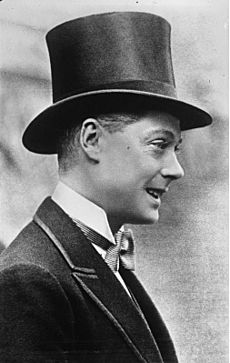
In the 1930s, the Ritz was like a club where you were sure to see your friends. It had a mix of elegance and comfort. The staff were friendly and knew everyone.
Lord Lurgan, who became chairman of the Ritz in 1928, wanted to attract American guests. He was friends with the Earl of Carnavon, who often stayed at the hotel. In 1931, the Aga Khan held meetings at the hotel, attended by Mahatma Gandhi.
The future Edward VIII and his friends were often seen at the Ritz in the 1930s. He even practiced his dancing there! In 1934, Edward's brother, the Duke of Kent, got married at the Ritz. The Queen Mother also attended private parties. At one time, four kings and queens stayed at the Ritz at the same time!
The Great Depression in the 1930s made business slow down. Staff wages were cut by 25% in 1931. To make more money, the hotel started putting on Cabaret shows in 1935. These shows were very popular. The BBC even broadcast live performances from the hotel's restaurant. The famous song "Puttin' On the Ritz" became popular through these shows.
The Ritz During World War II

During World War II, the Ritz became a safe place for many important people. Royals, wealthy families, and politicians moved into the hotel. In 1940, the Albanian royal family, including King Zog I, lived at the hotel. They had their own floor and bodyguards. King Zog brought his royal gold and jewels, which were kept safe at the Ritz.
The hotel was hit by bombs nine times during the war, but it stayed open. The restaurant had to close twice.
Many important leaders met at the Ritz during the war. In 1942, Winston Churchill, Dwight Eisenhower, and Charles de Gaulle met in the Marie Antoinette suite to talk about war plans. Many writers and politicians also dined regularly at the Ritz during this time.
The Ritz in Later Years

After World War II, the Bracewell-Smith family owned the hotel for about 30 years. There were some tough times, including a workers' strike in 1946.
But the Ritz continued to be a social hotspot for important people in the 1950s. The wealthy Aga Khan family often visited. J. Paul Getty, who was said to be the richest man in the world, lived at the Ritz after the war. Film stars like Rita Hayworth and Tallulah Bankhead were also regular guests.
In 1959, Patrice Lumumba, the Prime Minister of Congo, stayed at the hotel. He met with other leaders there.
George Criticos was the head porter at the Ritz for 45 years, retiring in 1960. He remembered many famous people and events. He even helped the Aga Khan with horse racing bets!
The Ritz from the 1960s to Today
In the 1960s, London's social scene changed. The Ritz's high standards had dropped a bit. But celebrities still held parties there, and the Rolling Stones were guests for many years. British Prime Ministers like Harold Wilson and Edward Heath often had lunch at the Ritz.
In the 1970s, the hotel faced new challenges. There were bomb threats, and the oil crisis affected business. The Bracewell-Smith family sold the hotel to Trafalgar House in 1976 for £2.75 million. At that time, only 45% of the rooms were full.
In 1984, the Ritz brought back its popular weekly Sunday tea dances from the 1920s and 1930s. Afternoon tea at the Ritz became so popular that reservations are now required. Guests must also dress nicely; Mick Jagger was once turned away for not wearing a jacket and tie!
The Barclay twins bought the hotel in 1995 for £80 million. They spent eight years and £40 million to restore it to its original beauty. After Princess Diana's death, Prince Charles and Camilla Parker-Bowles made their first public appearance together at the Ritz. In 2002, the Ritz received a special award from Prince Charles for its excellent catering services.
In 2005, the Ritz bought the building next door, Wimbourne House. In 2007, a small fire in the basement casino kitchen caused about 300 people to be evacuated, but no one was hurt. Former British Prime Minister Margaret Thatcher was staying at the Ritz when she passed away in 2013.
The hotel was sold to a Qatari investor in March 2020.
The Ritz London's Design
Many people believe the Ritz is a masterpiece of hotel design. The architects, Charles Mewès and Arthur J. Davis, studied at a famous art school in Paris. Their training is clear in the hotel's design, which has a strong French classical style. Mewès had already designed the Hotel Ritz in Paris before working on the London Ritz.
The outside of the Ritz looks like it could be in Paris or America, with very little traditional English style. The arcades on the Piccadilly side look like the famous Rue de Rivoli in Paris. The tall windows and wall panels are similar to Mewès's earlier work.
Building the hotel started in June 1904 and finished by October 1905. It opened in May 1906. The builders faced challenges because the site was narrow. All the materials had to be brought in carefully. The old foundations had to be blasted away to make way for the new steel structure.
The total cost to build the hotel was about £345,227. The steel frame was made in Germany. It was designed to be very fire-resistant. The walls were also made fireproof using special blocks. The hotel's floors were also fireproof. On the corners of the roof, you can see large green copper lions, which are the hotel's symbol.
Inside the Ritz: A Look at the Interior
The inside of the Ritz was designed mostly by London and Paris designers in the Louis XVI style. This style is seen throughout the hotel, giving it a special feeling of elegance. Marcus Binney calls the main ground-floor rooms "one of the all-time masterpieces of hotel architecture." He says they are like a royal palace with their grand views and sparkling chandeliers.
The original plan from 1906 showed a large main restaurant, a Grand Gallery, and a Winter Garden. The Grill Room had its own entrance. Today, the Grill Room area is home to the Ritz Club. A long, arched hallway called the Long Gallery runs from one end of the hotel to the restaurant. It has beautiful carpets and arches. The main staircase was designed so that women could make a "dramatic entrance" and show off their dresses.
The Palm Court: A Famous Spot
The Palm Court is the most famous part of the Ritz. It's a beautiful, cream-colored room in the Louis XVI style. It has fancy furniture, including gold armchairs. The room has mirrors with gold frames and a high ceiling with gold decorations.
The fountain in the Palm Court is made of marble and has a gold nymph statue. The glass roof has two gold lanterns. The room has been decorated in soft apricot colors since 1906. César Ritz chose this color because he thought it made women's complexions look better.
The Palm Court is where the world-famous "Tea at the Ritz" takes place. Famous people like King Edward VII, Sir Winston Churchill, and Queen Elizabeth, the Queen Mother have enjoyed tea here. It became the place for tea in London after World War I. In the 1920s, a small orchestra would play music in the court.
Dining at the Ritz
The Ritz has six private dining rooms, including the Marie Antoinette Suite. Marcus Binney says the main restaurant is "not only one of the most beautiful interiors in London, it can be claimed as the most beautiful restaurant in the world."
The restaurant has beautiful bronze decorations and chandeliers. The ceiling is painted to look like a blue sky with clouds. Large mirrors on one side make the room feel very spacious.
During a big renovation in 1977, the workers hid their scaffolding with cloth so diners wouldn't be disturbed. Many original features were restored, and new items were made to look exactly like the old ones. The hotel even kept its old-fashioned call buttons for maids and waiters.
From the beginning, French chefs ran the kitchen. They even had a specialist in Russian soups and Viennese pastries. The cakes were so famous that King Edward would order them from Buckingham Palace. The Ritz is known for its excellent catering. You often need to book a table at the restaurant weeks in advance.
The Rivoli Bar, built in the Art Deco style, was designed in 2001 to look like a bar on the Orient Express.
The Marie Antoinette Suite
The Marie Antoinette Suite is next to the main restaurant. It has beautiful gold details and floral designs, inspired by Marie Antoinette. There are statues of Spring and Summer in the entrance lobby. The walls are decorated like picture frames.
Rooms and Suites
The Ritz London has 136 guestrooms. These include 111 bedrooms and 25 suites. The bedrooms come in different sizes, from Superior Queen to Deluxe King. The suites also come in various types, including Junior Suites, Executive Suites, and the special Royal Suite and Prince of Wales Suite. These suites have fireplaces, gold decorations, and antique furniture.
William Kent House
William Kent House is an extension of the Ritz. It has been turned into a special area for events, with rooms like the Music Room and the Queen Elizabeth Room. It also has three of the Ritz's top suites. This historic building was carefully restored and updated with modern touches hidden by period furniture. The restoration won a gold medal in 2007.
The Ritz Club: A Casino in the Basement
The Ritz Club is a casino located in the basement of the hotel. This space used to be the Ritz ballroom. In 1906, the basement was described as very grand, with ivory-white decor and mirrors. It was used for dinners, balls, and shows.
During World War II, this area became a nightclub called La Popote. It was decorated to look like a combat dugout. After the war, it became less popular. The bar, known as "Laurie's Bar," closed in 1976.
In 1977, the basement was leased out, and the Ritz Club casino opened in 1978. It was restored to the hotel's original 1906 Louis XVI style. The decorations included 6,000 sheets of gold leaf! The ceiling above the gaming tables was painted to look like a blue sky with clouds. The furniture was restored or replaced with exact copies.
When it opened, the Ritz Club was only for members and hotel guests. It charges a fee to enter. The games are considered "high stakes," meaning the minimum bets are usually very high. They offer games like roulette, black jack, baccarat, and poker, as well as some slot machines.
In 1998, the club was bought by London Clubs. It reopened with exclusive membership. As of 2006, the Ritz Club has a restaurant, bar, lounge, and a private gaming room.
The Ritz in Books and Movies
The Ritz London has appeared in many books and movies. Evelyn Waugh's 1942 novel Work Suspended has a scene at the Ritz. Alan Bennett's play, Forty Years On, is set in the Ritz basement during the war. In the book Good Omens, two main characters, an angel and a demon, often visit the Ritz.
The hotel is mentioned in the song "A Nightingale Sang in Berkeley Square" and in Queen's song "Good Old Fashioned Lover Boy". The hotel's name also inspired the word "ritz" and the phrase "to put on the Ritz." This phrase means to dress or act in a very fancy way. It also inspired the Irving Berlin song "Puttin' on the Ritz". Parts of the 1999 romantic comedy Notting Hill were filmed at and around the hotel.
See also
 In Spanish: Hotel Ritz (Londres) para niños
In Spanish: Hotel Ritz (Londres) para niños


